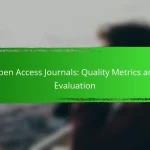What are the current trends in academic publishing?
The current trends in academic publishing reflect a shift towards greater accessibility, collaboration, and integration of technology. Key developments include the rise of open access models, the use of digital platforms, and an emphasis on data sharing and interdisciplinary research.
Open access publishing growth
Open access publishing is rapidly expanding, allowing researchers to share their findings without paywalls. This model enhances visibility and accessibility, making research available to a broader audience, including practitioners and the general public.
Many funding agencies now require open access for research outputs, which has further accelerated this trend. Researchers should consider publishing in reputable open access journals to comply with funding mandates and increase their work’s impact.
Increased use of digital platforms
Digital platforms are becoming essential for academic publishing, facilitating faster dissemination of research. Online repositories and preprint servers allow researchers to share their findings quickly, often before formal peer review.
These platforms also enable interactive features, such as multimedia content and data visualization, enhancing reader engagement. Academics should leverage these tools to reach wider audiences and improve the presentation of their work.
Focus on data sharing and transparency
There is a growing emphasis on data sharing and transparency in research practices. Many journals now require authors to provide access to their datasets, promoting reproducibility and trust in scientific findings.
Researchers should adopt best practices for data management and sharing, including using standardized formats and providing clear documentation. This not only meets journal requirements but also fosters collaboration and innovation in their fields.
Collaboration with technology companies
Collaboration between academic institutions and technology companies is on the rise, driving innovation in publishing. These partnerships can lead to the development of new tools for data analysis, manuscript submission, and peer review processes.
Researchers should explore opportunities to work with tech firms to enhance their publishing experience and improve the efficiency of their research workflows. Such collaborations can also provide access to cutting-edge technologies that may not be available within academia.
Shift towards interdisciplinary research
Interdisciplinary research is increasingly valued in academic publishing, as complex global challenges require insights from multiple fields. This trend encourages collaboration across disciplines, leading to more comprehensive solutions.
Researchers should consider forming interdisciplinary teams to tackle significant issues, as this approach can enhance the quality and impact of their work. Journals are increasingly receptive to publishing interdisciplinary studies, reflecting the evolving landscape of academic research.
How is open access impacting academic publishing in the UK?
Open access is significantly transforming academic publishing in the UK by making research freely available to the public. This shift enhances accessibility, allowing a wider audience to engage with scholarly work without financial barriers.
Increased visibility for researchers
Open access publishing increases the visibility of researchers by allowing their work to reach a broader audience. With research articles available for free, more academics, practitioners, and the general public can discover and cite their findings, enhancing their academic reputation.
For instance, studies have shown that open access articles are cited more frequently than those behind paywalls, which can lead to greater recognition and collaboration opportunities for researchers.
Changes in funding models
The rise of open access has led to changes in funding models for academic publishing. Many institutions and funding bodies in the UK now require researchers to publish their work in open access formats, often providing financial support for article processing charges (APCs).
Researchers should be aware of the various funding sources available, such as institutional funds or grants specifically allocated for open access publishing, to cover these costs effectively.
Impact on subscription-based journals
Open access is challenging traditional subscription-based journals by diverting readership and funding away from them. As more researchers choose to publish in open access venues, subscription journals may face declining revenues and readership.
This shift could lead to a reevaluation of subscription models, with some journals adopting hybrid approaches that combine open access and traditional subscription methods to remain viable in the changing landscape.
What role do digital tools play in academic publishing?
Digital tools significantly enhance the efficiency and accessibility of academic publishing. They streamline processes such as peer review, manuscript submission, and content creation, making it easier for researchers to disseminate their work.
Enhanced peer review processes
Digital tools facilitate a more efficient peer review process by allowing for quicker communication between authors and reviewers. Online platforms can automate the assignment of reviewers, track submissions, and manage feedback, reducing the time from submission to publication.
Many journals now use specialized software that enables real-time updates and notifications, which helps maintain transparency and accountability. This shift often leads to improved quality of reviews and faster turnaround times, benefiting both authors and readers.
Improved manuscript submission systems
Modern manuscript submission systems simplify the submission process for authors, allowing them to upload documents, track their status, and receive notifications all in one place. These systems often support multiple file formats and provide templates to ensure compliance with journal standards.
Additionally, many platforms offer integrated plagiarism detection tools, which help maintain the integrity of published work. Authors should familiarize themselves with the specific requirements of their target journals to avoid common pitfalls during submission.
Integration of AI in content creation
Artificial intelligence is increasingly being utilized in content creation within academic publishing. AI tools can assist researchers in drafting manuscripts, suggesting relevant literature, and even generating data visualizations, which can save time and enhance the quality of submissions.
However, while AI can be a valuable resource, it is crucial for authors to critically evaluate AI-generated content to ensure accuracy and originality. Relying too heavily on AI without proper oversight can lead to issues with credibility and authenticity in published research.
How are universities adapting to publishing trends?
Universities are increasingly adjusting their strategies to align with emerging trends in academic publishing. This includes embracing open access, enhancing research data management, and forming strategic partnerships with publishers to improve visibility and accessibility of research outputs.
Investment in open access initiatives
Many universities are allocating funds to support open access initiatives, which allow researchers to publish their work without subscription barriers. This investment not only increases the reach of academic research but also enhances the institution’s reputation in the global academic community.
For instance, universities may cover article processing charges (APCs) for faculty publications in open access journals. This financial support can encourage more researchers to choose open access options, ultimately leading to higher citation rates and broader dissemination of knowledge.
Support for research data management
Effective research data management is crucial for compliance with funding agency requirements and for maximizing the impact of research findings. Universities are establishing dedicated services to assist researchers in organizing, storing, and sharing their data securely and transparently.
These services often include training sessions on best practices, tools for data storage, and guidance on data sharing policies. By providing these resources, universities help researchers navigate the complexities of data management while promoting open science principles.
Partnerships with publishers
Forming partnerships with academic publishers allows universities to enhance their publishing capabilities and access a wider range of resources. These collaborations can lead to joint initiatives that support open access publishing and improve the visibility of university research.
For example, some institutions partner with publishers to create institutional repositories or to develop tailored publishing platforms that meet specific academic needs. These partnerships can also facilitate access to high-quality journals and increase the impact of research outputs among peers and the public.
What are the challenges faced by academic publishers?
Academic publishers encounter several challenges that impact their operations and the dissemination of research. Key issues include maintaining quality in open access models, adapting to rapid technological changes, and balancing profit with accessibility for researchers and institutions.
Maintaining quality in open access
Quality control in open access publishing is crucial to ensure the integrity of academic research. Publishers must implement rigorous peer-review processes while managing the influx of submissions, which can be overwhelming in an open access environment.
To maintain high standards, publishers can adopt best practices such as establishing clear guidelines for authors, utilizing experienced reviewers, and leveraging technology for plagiarism detection. This helps to uphold the credibility of published work.
Adapting to rapid technological changes
The academic publishing landscape is evolving quickly due to advancements in technology. Publishers need to stay updated with new tools and platforms that enhance the publishing process and improve user experience.
For example, adopting digital formats and interactive content can engage readers more effectively. Publishers should also consider integrating data analytics to track readership and impact, which can inform future publishing strategies.
Balancing profit with accessibility
Finding a balance between profitability and accessibility is a significant challenge for academic publishers. While open access models can increase visibility and readership, they often require funding to cover publication costs.
Publishers can explore various funding models, such as article processing charges (APCs) or institutional partnerships, to support open access initiatives. However, it is essential to ensure that these costs do not create barriers for researchers, particularly those from underfunded institutions.
What are the future directions for academic publishing?
The future of academic publishing is likely to be shaped by technological advancements, open access initiatives, and evolving researcher needs. These trends will influence how research is disseminated, accessed, and evaluated in the coming years.
Emergence of new publishing models
New publishing models are emerging to address the limitations of traditional academic publishing. These models include open access, where research outputs are freely available to the public, and collaborative platforms that allow for community-driven content creation and peer review.
For instance, open access journals often charge authors publication fees, which can range from a few hundred to several thousand dollars. This model increases accessibility but raises questions about funding and sustainability. Additionally, preprint servers are gaining popularity, allowing researchers to share their findings before formal peer review, expediting the dissemination of knowledge.
Researchers should consider the implications of these new models on their work. Choosing the right publishing route can enhance visibility and impact but may also involve navigating complex licensing agreements and funding sources. It’s essential to stay informed about the evolving landscape to make strategic decisions.








